Trophic levels Study guides, Class notes & Summaries
Looking for the best study guides, study notes and summaries about Trophic levels? On this page you'll find 511 study documents about Trophic levels.
Page 2 out of 511 results
Sort by
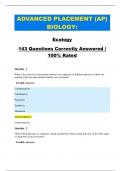
-
ADVANCED PLACEMENT (AP) BIOLOGY: Ecology 143 Questions Correctly Answered | 100% Rated
- Exam (elaborations) • 61 pages • 2023
- Available in package deal
-
- $12.00
- + learn more
ADVANCED PLACEMENT (AP) BIOLOGY: Ecology 143 Questions Correctly Answered | 100% Rated Question 1 What is the term for a relationship between two organisms of different species in which one benefits while the other neither benefits, nor is harmed? Possible Answers: Commensalism Cohabitation Parasitism Symbiosis Mutualism Correct answer: Commensalism Question 2 Of the following types of organism, which can directly obtain energy from any of the other types of organisms in...
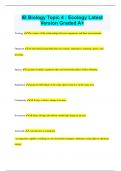
-
IB Biology Topic 4 : Ecology Latest Version Graded A+
- Exam (elaborations) • 11 pages • 2024
- Available in package deal
-
- $9.99
- + learn more
IB Biology Topic 4 : Ecology Latest Version Graded A+ Ecology The science of the relationships between organisms and their environments. Organism an individual living thing that uses energy, reproduces, responds, grows, and develops Species a group of similar organisms that can breed and produce fertile offspring Population group of individuals of the same species that live in the same area Community all living, or biotic, things in an area Ecosystem all biotic (living) and...
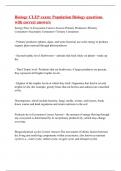
-
Biology CLEP exam: Population Biology questions with correct answers
- Exam (elaborations) • 12 pages • 2023
-
- $13.99
- + learn more
Energy Flow in Ecosystem Correct Answer-Primary Producers>Primary Consumers>Secondary Consumers>Tertiary Consumers - Primary producers (plants, algae, and some bacteria) use solar energy to produce organic plant material through photosynthesis. - Second trophic level: Herbivores—animals that feed solely on plants—make up the. - Third Tropic level: Predators that eat herbivores; if larger predators are present, they represent still higher trophic levels. - Highest of th...
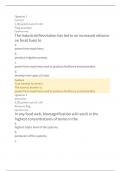
-
ENVS 1126 Test 3 (Louisiana state university)
- Exam (elaborations) • 37 pages • 2023
-
- $19.49
- + learn more
Question 1 Correct 1.00 points out of 1.00 Flag question Question text The Industrial Revolution has led to an increased reliance on fossil fuels to a. power farm machinery. b. produce irrigation pumps. c. power farm machinery and to produce fertilizers and pesticides. d. develop new types of crops. Feedback Your answer is correct. The correct answer is: power farm machinery and to produce fertilizers and pesticides. Question 2 Incorrect 0.00 points out of 1.00 Remove flag ...
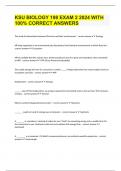
-
KSU BIOLOGY 198 EXAM 2 2024 WITH 100% CORRECT ANSWERS
- Exam (elaborations) • 12 pages • 2024
-
- $16.49
- + learn more
KSU BIOLOGY 198 EXAM 2 2024 WITH 100% CORRECT ANSWERS The study of interactions between life forms and their environment. - correct answer Ecology All living organisms in an environment plus the physical and chemical environments in which they live. - correct answer Ecosystem All the sunlight that hits a given area, primary producers use it to grow and reproduce, then converted to NPP - correct answer GPP (Gross Primary Productivity) The usable energy left over for consumers is cal...
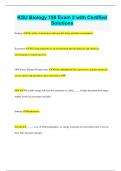
-
KSU Biology 198 Exam 2 with Certified Solutions
- Exam (elaborations) • 19 pages • 2024
- Available in package deal
-
- $9.99
- + learn more
KSU Biology 198 Exam 2 with Certified Solutions Ecology The study of interactions between life forms and their environment. Ecosystem All living organisms in an environment plus the physical and chemical environments in which they live. GPP (Gross Primary Productivity) All the sunlight that hits a given area, primary producers use it to grow and reproduce, then converted to NPP NPP The usable energy left over for consumers is called ____. It helps determine how many trophic lev...
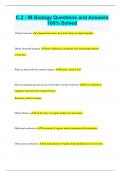
-
C.2 - IB Biology Questions and Answers 100% Solved
- Exam (elaborations) • 4 pages • 2024
- Available in package deal
-
- $8.49
- + learn more
C.2 - IB Biology Questions and Answers 100% Solved Define food web. a diagram that shows how food chains are linked together. Define Gersmehl diagram. shows differences in nutrient flow and storage between ecosystems. What are three sinks for nutrient storage? Biomass, litter & Soil How are nutrients put into an ecosystem? How are they removed? Put in: nutrients in raindrops, nutrients from weathered rocks. Removed: runoff, leaching. Define biomass. total dry mass of organic...
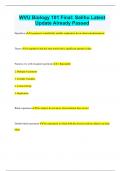
-
WVU Biology 101 Final: Salihu Latest Update Already Passed
- Exam (elaborations) • 15 pages • 2024
- Available in package deal
-
- $9.99
- + learn more
WVU Biology 101 Final: Salihu Latest Update Already Passed Hypothesis A proposed, scientifically testable explanation for an observed phenomenon. Theory A hypothesis that has been tested with a significant amount of data Features of a well designed experiment 1. Repeatable 2. Multiple Treatments 3. Testable Variables 4. Control Group 5. Replication Blind experiment The subjects do not know what treatment they receive Double-blind experiment An experiment in which both the o...
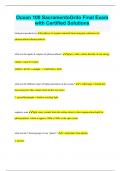
-
Ocean 100 SacramentoGrilo Final Exam with Certified Solutions
- Exam (elaborations) • 16 pages • 2024
- Available in package deal
-
- $9.99
- + learn more
Ocean 100 SacramentoGrilo Final Exam with Certified Solutions biological productivity synthesis of organic materials from inorganic substances by photosynthesis/chemosynthesis what are the inputs & outputs of photosynthesis? inputs: water, carbon dioxide, & sun energy outputs: sugar & oxygen (6H2O + 6CO2 + sunlight - > C6H12O6 + 6O2) what are the different types of light penetration in the oceans? 1. red/orange = turned into heat energy b/c they cannot reach all the way down ...
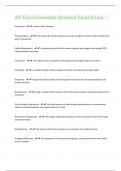
-
AP Environmental Science Final Exam | 200 Questions and Answers(A+ Solution guide)
- Exam (elaborations) • 17 pages • 2023
- Available in package deal
-
- $12.49
- + learn more
Succession - -recovery after disaster Photosynthesis - -the process by which producers use solar energy to convert carbon dioxide and water into glucose Cellular Respiration - -the process by which cells convert glucose and oxygen into energy (ATP), carbon dioxide, and water Food Chain - -the sequence of consumption from producers through tertiary consumers Food Web - -a complex model of how energy and matter move between trophic levels Detrivores - -organisms that specialize in breaking ...

$6.50 for your textbook summary multiplied by 100 fellow students... Do the math: that's a lot of money! Don't be a thief of your own wallet and start uploading yours now. Discover all about earning on Stuvia


